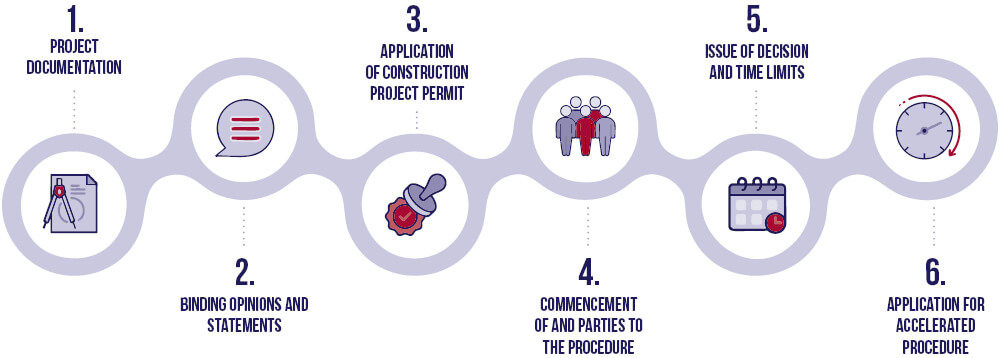In July 2024, the Czech Republic implemented a new Building Act, heralded as a revolution that would streamline the permitting process and reduce bureaucratic red tape. However, the transition to this new system has been anything but smooth, plagued by significant complications. So what is the current state of applying for a building permit – is it a digital or paper-based process? We will explore this using the example of a family house.
We will guide you through the entire process – from project documentation, to obtaining binding opinions, submitting the application, and finally securing the necessary permits.
On 1 July 2024, building authorities began accepting new applications to permit construction projects under the new Building Act. However, the promise of a simple, digitised building permit procedure has not materialised. The transition to the modern system was plagued by technical failures, office chaos, and complaints from frustrated applicants – prompting government intervention and the implementation of a "bypass" to replace the dysfunctional aspects of the digitalised procedure and allow for at least the partial processing of applications.
Project documentation
Before you submit your application for the approval of your construction project, you should have precise and well-prepared project documentation in hand. This documentation is the cornerstone of the entire procedure. You will need it to obtain binding opinions or statements, as well as for the building authority to approve the construction project. You will also use this documentation to secure the necessary consents from neighbours and other parties, which, for instance, is especially important for an accelerated procedure.
Stavba rodinného domu bude v naprosté většině případů jednoduchou stavbou, za kterou se považuje dům se dvěma nadzemními podlažími (případně podkrovím nebo ustoupeným patrem) a jedním podzemním podlažím – podle stavebního zákona k ní nicméně musí projektovou dokumentaci vypracovat vždy projektant.
For most family houses, the construction will be straightforward, as a family house is deemed to mean a two-storey building, possibly with an attic or a recessed storey, and one underground storey. However, the Building Act requires that the project documentation always be prepared by a designer.
The new Building Act has relaxed the documentation requirements. For example, the act has eased requirements for the projects themselves on the number of parking spaces, sun exposure of apartments, and spacing between buildings. In general, the Building Act still requires that the spacing between buildings must allow for maintenance and comply with urban design, architectural, and other regulatory requirements.
The new Building Act has relaxed the documentation requirements. For example, the act has eased requirements for the projects themselves on the number of parking spaces, sun exposure of apartments, and spacing between buildings. In general, the Building Act still requires that the spacing between buildings must allow for maintenance and comply with urban design, architectural, and other regulatory requirements.
The decree requires family houses to be built with respect to the building line and at least 2 meters from the land boundaries line, excluding lands of public open spaces. However, the decree does allow for exceptions to this distance requirement.
When building a family house in Prague, Brno, or Ostrava, be mindful of the cities' distinct municipal building regulations. Each location has unique requirements that can significantly impact the design and placement of your project. Be sure to thoroughly review and comply with the local building codes to avoid any issues.
Binding opinions
Once you have the complete project documentation, you have finished the first step and can now move on to the next phase – securing approvals and binding opinions. The individuals or entities from whom you will need stamps, consent, or signatures for your project depend largely on your house’s specific design, location, the technology used, and other technical or architectural elements.
The new Building Act imposes an obligation on building authorities to obtain opinions from the competent authorities on their own if applicants fail to provide them. Additionally, authorities cannot consider an application defective if it is missing some opinions, even if the applicant did not submit a complete set of required opinions.
While applying for a building permit, you have the option to let the authorities handle the relevant document collection. However, keep in mind that this will suspend the decision time limits until the authorities provide their binding opinions or the "presumption of consent" occurs. This can result in significant and unpredictable delays. Considering the overburdened building authorities, we do not recommend this procedure in general. Instead, we advise that you obtain all the necessary opinions yourself. This approach will help minimise any delays or surprises from the authorities.
You will usually need a statement from the owner of the access road and from the energy or water company, which for example will give their statements in respect of the connection to the electricity grid or water supply line. While you cannot apply for such statements through the Builder’s Portal, these companies usually have online application forms on their own websites.
The introduction of the Unified Environmental Opinion (UEO) is a significant innovation, as it consolidates up to 26 different binding opinions, statements, or decisions under environmental laws into a single binding opinion. However, this unification comes at the cost of extending the time limit for issuing the opinion.
If your construction project requires permits under the Building Act, the Nature and Landscape Protection Act, or an Environmental Impact Assessment under the EIA Act, you must apply for the UEO.
Application
So you have the necessary documentation, opinions, and approvals lined up – now the question is how to submit the application. Currently, you can apply for the permit of a family house project in either hard-copy form or digitally through the online Builder’s Portal.
To submit a hard-copy application, fill in the relevant form and deliver it, along with supporting documents, to the competent building authority. Alternatively, you can send the form by Data Box. However, if you choose a hard-copy application, remember to include the project documentation in the Electronic Documentation Register by the application submission date. Failure to do so will result in the building authority postponing your application.
Applicants can also submit their entire application digitally through the Builder's Portal on the Building Administration Portal website. This option allows you to log in, for example, using your bank identity.
The application allows you to directly upload all required documents. It also prevents formal defects by prohibiting submission without complete details. In general, the application must include basic information about the construction project, such as its scope, purpose, implementation method and timeline, and identification of the building or land location on which you will implement the project.
The application includes the necessary documents that the building authority will assess the admissibility of the project.
To obtain a construction project permit, you will need to provide the following in particular:
- Project documentation;
- Planning agreement, if executed (a new requirement);
- Consent from the owner of the land or the structure on which the project will be implemented;
- Statements, binding opinions, or decisions from the relevant authorities under special legislation;
- Statements from the owners of any public transportation or technical infrastructure shown on the digital technical map.
The building authority will ask you to remove any deficiencies found in your application. This will suspend the time limit for issuing the permit, with a new time limit beginning once a corrected application is submitted. You can complete the application through the Builder's Portal.
Within 7 days of receiving a defect-free application or the removal of any defects, the building authority must notify all involved parties to the procedure, including the main designer, that the proceedings have commenced.
The date of notice for initiating the procedure is crucial, as it marks the start of the objection period for parties or the public. The parties must have at least 15 days to submit their objections.
Beyond you as the builder and your neighbours, the parties to the procedure include the municipality where you plan to build, the landowners or structure owners on which your project will be implemented, and any third parties holding other rights in rem in the land or structure – for example pre-emption rights or easements (such as path usage). Additionally, certain laws may designate other parties, such as environmental associations under the Nature and Landscape Protection Act or the public concerned under the EIA Act, to have standing in the procedure.
For a family house, you typically don't need to undergo an Environmental Impact Assessment under the EIA Act. However, for larger-scale family houses to be permitted near important green spaces or particularly protected areas, if the decision is based on a special permit (UEO) to cut down trees or exemption from particularly protected species, environmental associations can directly participate in the project permit procedure under the Nature and Landscape Protection Act.
Objections
As outlined above, a 15-day period for objections begins to run from the date of proper delivery of a notice of commencement of the building permit procedure. During this period, individual parties may object only to the extent that the project affects their rights. For instance, a neighbour could object that the building is too close but could not object that it endangers a rare animal. If any objections are received by the building authority within the time limit, the authority will investigate whether they are justified. If grounds are found, the authority will invite you to make a statement and give you a reasonable period to do so.
Decision
The building authority will rule on your application within the statutory time limits, once they have reviewed all objections from all parties to the procedure and assessed the project documentation and related documents. Or at least they should do so.
The building authority must assess a defect-free application for the permit of a family house that is a simple structure within 30 days of receipt or the removal of any defects in the application. The authority can extend this time limit by only 30 more days, or up to 60 days in special cases defined by law, provided certain conditions are met.

If the building authority approves your construction project as compliant with the Building Act and other regulations, the land use plan, and the opinions of all the authorities concerned, they will issue the permit. At this stage, you may feel like you have reached the finish line, but don’t celebrate just yet. The permit is not final on the day it is issued. Within 15 days of its delivery, the parties involved have the right to appeal the building authority’s decision. But if no one appeals within this time frame, congratulations! You can start building.
Accelerated building permit procedure
A major innovation in speeding up the building permitting process is the accelerated procedure. Under this approach, the building authority issues a decision on the permit as the first step in the procedure, eliminating the conventional planning permission process. With no submission of objections from the parties to the building permit procedure, this streamlined process allows for faster approvals.
To conduct the accelerated procedure, the building authority requires you to explicitly request it in your application and meet all the necessary conditions. If all potential parties agree, the construction can be approved on an expedited basis without the submission of objections. Therefore, your application for accelerated procedure must include specific requirements, particularly the consents of all parties involved, which must be indicated on the layout drawing. Be sure not to overlook any parties, as this would negatively impact the accelerated procedure and its outcome.
To qualify for the accelerated procedure, several additional criteria must be met: The municipality where you plan to build must have an approved land use plan in place. Additionally, your project must not be subject to an Environmental Impact Assessment (EIA) and must not require an exemption under the Nature and Landscape Protection Act. Lastly, your project must fully comply with the requirements outlined in the Building Act.
Failing to meet all the conditions of the accelerated procedure does not result in your application being dismissed or postponed. Instead, the building authority will initiate the "classic" building permit procedure as outlined above.










